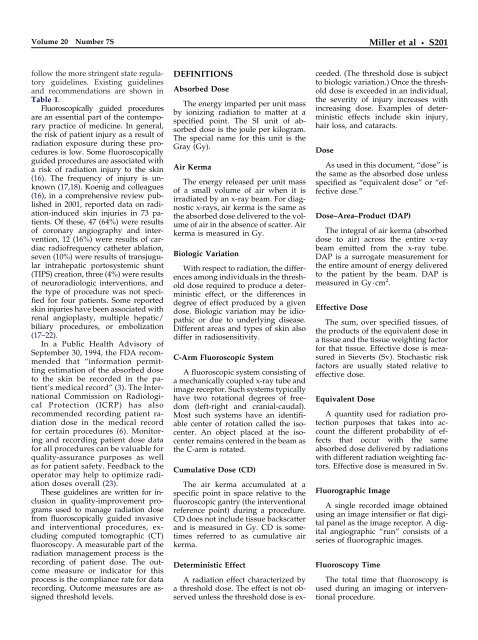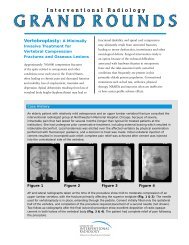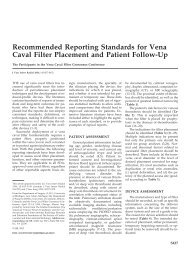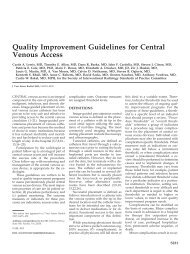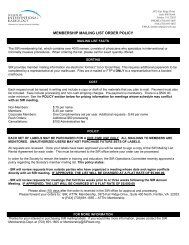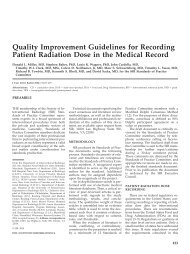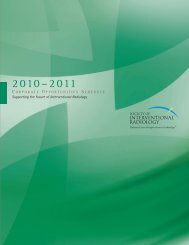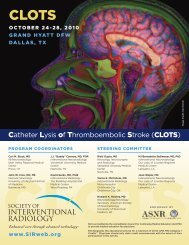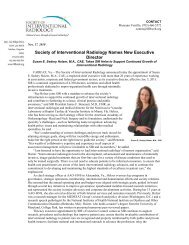Quality Improvement Guidelines for Recording Patient Radiation ...
Quality Improvement Guidelines for Recording Patient Radiation ...
Quality Improvement Guidelines for Recording Patient Radiation ...
Create successful ePaper yourself
Turn your PDF publications into a flip-book with our unique Google optimized e-Paper software.
Volume 20Number 7SMiller et al • S201follow the more stringent state regulatoryguidelines. Existing guidelinesand recommendations are shown inTable 1.Fluoroscopically guided proceduresare an essential part of the contemporarypractice of medicine. In general,the risk of patient injury as a result ofradiation exposure during these proceduresis low. Some fluoroscopicallyguided procedures are associated witha risk of radiation injury to the skin(16). The frequency of injury is unknown(17,18). Koenig and colleagues(16), in a comprehensive review publishedin 2001, reported data on radiation-inducedskin injuries in 73 patients.Of these, 47 (64%) were resultsof coronary angiography and intervention,12 (16%) were results of cardiacradiofrequency catheter ablation,seven (10%) were results of transjugularintrahepatic portosystemic shunt(TIPS) creation, three (4%) were resultsof neuroradiologic interventions, andthe type of procedure was not specified<strong>for</strong> four patients. Some reportedskin injuries have been associated withrenal angioplasty, multiple hepatic/biliary procedures, or embolization(17–22).In a Public Health Advisory ofSeptember 30, 1994, the FDA recommendedthat “in<strong>for</strong>mation permittingestimation of the absorbed doseto the skin be recorded in the patient’smedical record” (3). The InternationalCommission on RadiologicalProtection (ICRP) has alsorecommended recording patient radiationdose in the medical record<strong>for</strong> certain procedures (6). Monitoringand recording patient dose data<strong>for</strong> all procedures can be valuable <strong>for</strong>quality-assurance purposes as wellas <strong>for</strong> patient safety. Feedback to theoperator may help to optimize radiationdoses overall (23).These guidelines are written <strong>for</strong> inclusionin quality-improvement programsused to manage radiation dosefrom fluoroscopically guided invasiveand interventional procedures, excludingcomputed tomographic (CT)fluoroscopy. A measurable part of theradiation management process is therecording of patient dose. The outcomemeasure or indicator <strong>for</strong> thisprocess is the compliance rate <strong>for</strong> datarecording. Outcome measures are assignedthreshold levels.DEFINITIONSAbsorbed DoseThe energy imparted per unit massby ionizing radiation to matter at aspecified point. The SI unit of absorbeddose is the joule per kilogram.The special name <strong>for</strong> this unit is theGray (Gy).Air KermaThe energy released per unit massof a small volume of air when it isirradiated by an x-ray beam. For diagnosticx-rays, air kerma is the same asthe absorbed dose delivered to the volumeof air in the absence of scatter. Airkerma is measured in Gy.Biologic VariationWith respect to radiation, the differencesamong individuals in the thresholddose required to produce a deterministiceffect, or the differences indegree of effect produced by a givendose. Biologic variation may be idiopathicor due to underlying disease.Different areas and types of skin alsodiffer in radiosensitivity.C-Arm Fluoroscopic SystemA fluoroscopic system consisting ofa mechanically coupled x-ray tube andimage receptor. Such systems typicallyhave two rotational degrees of freedom(left-right and cranial-caudal).Most such systems have an identifiablecenter of rotation called the isocenter.An object placed at the isocenterremains centered in the beam asthe C-arm is rotated.Cumulative Dose (CD)The air kerma accumulated at aspecific point in space relative to thefluoroscopic gantry (the interventionalreference point) during a procedure.CD does not include tissue backscatterand is measured in Gy. CD is sometimesreferred to as cumulative airkerma.Deterministic EffectA radiation effect characterized bya threshold dose. The effect is not observedunless the threshold dose is exceeded.(The threshold dose is subjectto biologic variation.) Once the thresholddose is exceeded in an individual,the severity of injury increases withincreasing dose. Examples of deterministiceffects include skin injury,hair loss, and cataracts.DoseAs used in this document, “dose” isthe same as the absorbed dose unlessspecified as “equivalent dose” or “effectivedose.”Dose–Area–Product (DAP)The integral of air kerma (absorbeddose to air) across the entire x-raybeam emitted from the x-ray tube.DAP is a surrogate measurement <strong>for</strong>the entire amount of energy deliveredto the patient by the beam. DAP ismeasured in Gy·cm 2 .Effective DoseThe sum, over specified tissues, ofthe products of the equivalent dose ina tissue and the tissue weighting factor<strong>for</strong> that tissue. Effective dose is measuredin Sieverts (Sv). Stochastic riskfactors are usually stated relative toeffective dose.Equivalent DoseA quantity used <strong>for</strong> radiation protectionpurposes that takes into accountthe different probability of effectsthat occur with the sameabsorbed dose delivered by radiationswith different radiation weighting factors.Effective dose is measured in Sv.Fluorographic ImageA single recorded image obtainedusing an image intensifier or flat digitalpanel as the image receptor. A digitalangiographic “run” consists of aseries of fluorographic images.Fluoroscopy TimeThe total time that fluoroscopy isused during an imaging or interventionalprocedure.


